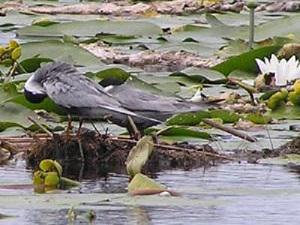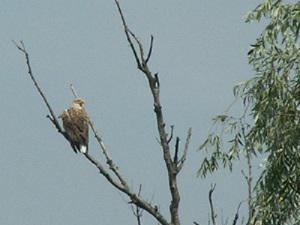Jan Van der Winden
The objective of the project is to prepare a bird conservation plan with a management vision for the area with a focus on endangered and vulnerable colonies of herons and terns. This will enhance the process of effective integrated bird protection of the intended establishment of a National Park.

Whiskered Terns in a colony. These tern colonies are widespread and vulnerable because of boat traffic and fishing activities. ©J. van der Winden
The Dniepr in Ukraine is the third largest European river. The Dniepr Delta with huge floodplains, marshes and islands is important for its biodiversity such as colonial waterbirds like terns and herons. The area is already a designated as a Ramsar site and Important Bird Area. Currently, the Ukraine authorities intend to designate it a National Natural Park.

Adult White-tailed Eagle a regular breeding and wintering species in the Dniepr Delta. ©P. Szczys
Among the three types of protected areas, the National Natural Park status in Ukraine has the least strict protection to nature. The current threats to the area and its birds are overfishing, touristic overexploitation (e.g. expanding summer settlements), hunting and the risk of wetland reclamation. The area has no restricted zones during the breeding season and the human pressure on the wetlands is increasing. This area turned out to be rich in tern and heron colonies. Both of these groups are declining in Europe due to water management and loss of habitat. It is important to conserve large source populations in Europe of terns and herons, which are important in the network of wetlands and can contribute to the robustness of European population. In contrast to e.g. the attention for the Danube Delta, the Dniepr Delta with its large waterbird colonies is hardly protected and recognised.
There is an excellent chance at this very moment to include the bird protection necessities in the legislation process. During earlier years bird inventories were conducted and good information is available to be used to direct the nature conservation. An overview of important breeding sites e.g. major tern and heron colonies will be identified and presented. Secondly these data will be used to prepare a conservation plan for these bird colonies and important breeding sites. This information will be provided to the local and national authorities and suggestions will be done e.g. for zonation of vulnerable areas such as heron and tern colony sites. Additionally, local stakeholders will be informed about the value of nature in the area. In this context, a booklet will be produced and schools will be included in awareness programmes.